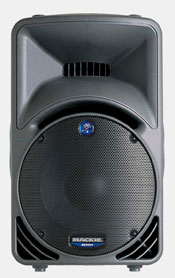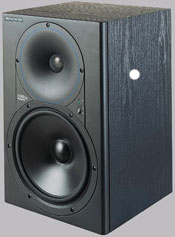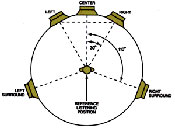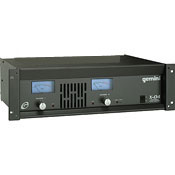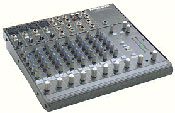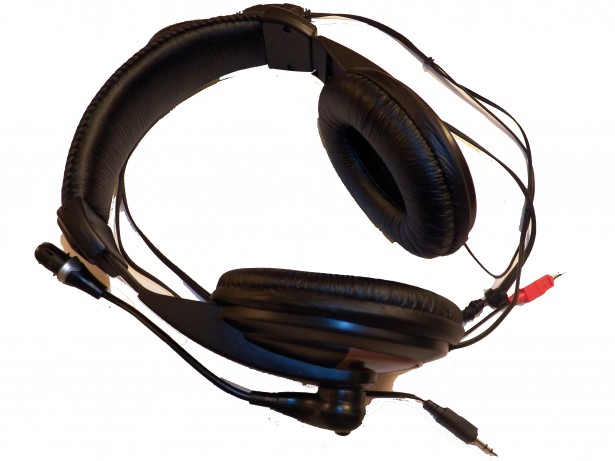Resource Guide Homepage
Resource Guide Homepage
Audio Components
Sound is a critical component of most moving image media art, and yet it is the technical element most often overlooked when installing and presenting media works. If you plan to amplify sound, rather than provide viewers with headphones, it is important to consider how sound will be contained and focused if multiple works will be shown in the same space. The following is a guide to common audio components, including speakers, amplifiers, mixers and cables.
Speakers come in a wide range of models; the best speakers for delivering audio in a large exhibition space are PA (public address) models, designed for projecting audio at high fidelity across all frequencies. Studio monitors, designed for high quality projection in small, quiet spaces, are acceptable for certain spaces or types of exhibition. Both come in active and passive models (defined below). There are other, more specialized options for projecting audio. Parabolic speakers, often used as a solution for competing sound elements in a single exhibition space, can help focus sound amplification to a specific viewing/listening area. Focused sound projection is further developed in a relatively new technology called "Audio Spotlight," where sound is audible only when one stands within a specified path. Finally, headphones isolate audio on a single viewer; a headphone mixer can accommodate multiple viewers/listeners.
Self-powered speakers are best exemplified by the stereo speakers that accompany your desktop computer. They require no external amplifier, as the amplifier is built into the speaker cabinet. Consumer grade self-powered speakers can sometimes be sufficient for an extremely intimate exhibition space, but for most exhibition environments they do not provide an adequate spectrum of sound nor sufficient volume. Professional quality self-powered speakers exist, but in certain circumstances, use of self-powered speakers in installation environments leads to "ground hum" - an audible 60 hertz hum or visible light rolling bars in the video image. This can occur when speakers are plugged into a different AC circuit than the video equipment, as is sometimes required in large presentation spaces. Also, the cables connecting the playback device to the self-powered speakers are prone to noise and interference when run over long distances.
Passive speakers are used in conjunction with an audio amplifier. The amplifier's wattage should be compatible with the watt capacity of the speakers. For example, a 200-watt amplifier should be used with two 100-watt speakers. For most exhibition spaces, 100 watts per channel (or number of speakers) will be more than sufficient.
Surround sound is required by some single-channel video works. It is important to correctly identify how many channels are needed. The most common surround sound ratio is 5:1 or 5 speakers:1 sub-woofer. This system has become popular with home theater enthusiasts in recent years. Note that inexpensive 5:1 surround sound packages can be found in the consumer market, but lower cost can sometimes indicate lower quality. There is no need for a pre-packaged system as long as you have the correct number of speakers, and your amplifier and audio playback equipment can accommodate surround sound. Choosing speakers with high, mid, and low range frequencies will yield the best results.
An audio amplifier is required if your speakers are not self-powered. Using an amplifier with quality passive speakers will allow for greater volume than self-powered speakers. It is important to make sure that the wattage capacity of your amplifier is compatible with your speakers. For example, if your amplifier can support 100 watts on each channel, use 100-watt speakers. Many amplifiers also include limiters, low frequency filters, and overload protection, though additional equipment can yield greater control. There are many distinctions between consumer "home stereo" and professional amplifiers. Professional equipment is designed for maximum sound fidelity at any volume, and is built to sustain longer hours of use.
Mixers are used to adjust audio signal and send it from different playback (or live) sources to amplifiers and speakers, or to send signal from a device with RCA outputs to an amplifier that only accepts XLR. Depending on the technical requirements of an exhibition, a mixer may or may not be necessary. Professional mixers come in many sizes, with different functions depending on size.
Headphones are a pair of transducers that receive a signal from a playback device and amplify that signal with speakers placed close to a listener's ears. When using headphones in an exhibition environment, earbuds, like those commonly used with iPods, should be avoided for reasons of sanitation and comfort. Although headphones can technically accommodate stereo (left and right) audio signals, the spatial qualities of a composition, present when amplified with speakers, can be lost. While headphones are an excellent solution for isolating sound in a space with multiple works, it is important to consider what elements, aural, visual, and environmental, may be compromised as a result.
